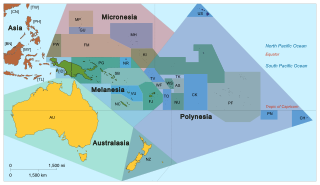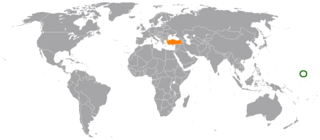
The Federated States of Micronesia are located on the Caroline Islands in the western Pacific Ocean. The history of the modern Federated States of Micronesia is one of settlement by Micronesians; colonization by Spain, Germany, and Japan; United Nations trusteeship under United States-administered Trust Territory of the Pacific Islands; and gradual independence beginning with the ratification of a sovereign constitution in 1979.

Kiribati, officially the Republic of Kiribati, is an independent island nation in the central Pacific Ocean. The permanent population is over 119,000 (2020), more than half of whom live on Tarawa atoll. The state comprises 32 atolls and one raised coral island, Banaba. They have a total land area of 811 square kilometres and are dispersed over 3.5 million km2 (1.4 million sq mi).

Micronesia is a subregion of Oceania, consisting of thousands of small islands in the western Pacific Ocean. It has a close shared cultural history with three other island regions: the Philippines to the west, Polynesia to the east, and Melanesia to the south—as well as with the wider community of Austronesian peoples.

The Gilbert Islands are a chain of sixteen atolls and coral islands in the Pacific Ocean, about halfway between Papua New Guinea and Hawaii. From 1976 to 1979, they were the “British colony of the Gilbert Islands”, and before that, from 1916 to 1975, they were the “Gilbert and Ellice Islands colony”. They constitute the main part of the nation of Kiribati.

Pacific Islanders, Pacificer, Pasifika, or Pasefika, are the peoples of the Pacific Islands—particularly those who are indigenous to them.

The Pacific Rim comprises the lands around the rim of the Pacific Ocean. The Pacific Basin includes the Pacific Rim and the islands in the Pacific Ocean. The Pacific Rim roughly overlaps with the geologic Pacific Ring of Fire.

Abaiang, also known as Apaiang, Apia, and in the past, Charlotte Island, in the Northern Gilbert Islands, is a coral atoll of Kiribati, located in the west-central Pacific Ocean. Abaiang was the home of the first missionary to arrive in Kiribati, Hiram Bingham II. Abaiang has a population of 5,502.

Leapfrogging, also known as island hopping, was a military strategy employed by the Allies in the Pacific War against the Empire of Japan during World War II.
Micronesian mythology comprises the traditional belief systems of the people of Micronesia. There is no single belief system in the islands of Micronesia, as each island region has its own mythological beings.
The Baháʼí Faith in Kiribati begins after 1916 with a mention by ʻAbdu'l-Bahá, then head of the religion, that Baháʼís should take the religion to the Gilbert Islands which form part of modern Kiribati. The first Baháʼís pioneered to the island of Abaiang(aka Charlotte Island, of the Gilbert Islands), on March 4, 1954. They encountered serious opposition from some Catholics on the islands and were eventually deported and the first convert banished to his home island. However, in one year there was a community of more than 200 Baháʼís and a Baháʼí Local Spiritual Assembly. Three years later the island where the first convert was sent to was found to now have 10 Baháʼís. By 1963 there were 14 assemblies. As the Ellice Islands gained independence as Tuvalu and the Gilbert Islands and others formed Kiribati, the communities of Baháʼís also reformed into separate institutions of National Spiritual Assemblies in 1981. The Baháʼís had established a number schools by 1963 and there are still such today - indeed the Ootan Marawa Baháʼí Vocational Institute being the only teacher training institution for pre-school teachers in Kiribati. All together the Baháʼís now claim more than 10,000 local people have joined the religion over the last 50 years and there are 38 local spiritual assemblies.
The nationality law of the Federated States of Micronesia determines who is or may become a citizen or national of the Federated States of Micronesia (FSM). Article III of the Constitution of the Federated States of Micronesia provides the basis for nationality law, while specific provisions are elaborated in 7 FSMC § 201 et seq.

Wa are traditional sailing outrigger canoes of the Caroline Islands, Palau, and Yap. They have a single outrigger. They are similar to the sakman of the Northern Marianas.

The Yapese people are a Micronesian ethnic group native to the main island of Yap. Under different administrative rules, Yapese culture has been influenced by Spanish, Japanese, German, and American cultures. Aspects of traditional Yapese culture are still important in modern Yapese culture.

The Turkish ambassador in Canberra, Australia is also accredited to Vanuatu. Vanuatu has an honorary consulate in Istanbul.

Palau–Turkey relations are foreign relations between Palau and Turkey. The Turkish ambassador in Tokyo, Japan is also accredited to Palau.

Marshall Islands–Turkey relations are foreign relations between the Marshall Islands and Turkey. The Turkish ambassador in Canberra, Australia is also accredited to the Marshall Islands. The Marshall Islands has an Honorary Consulate in Istanbul.
The Marianas archipelago of the Northern Pacific contains fourteen islands located between Japan and New Guinea on a north–south axis and Hawaii and the Philippines on an east–west axis. Inhabitants were Spanish nationals from 1521 until the Spanish-American War of 1898. Sold to Germany in 1899, the Mariana Islands were a German protectorate until 1919, when they became part of the South Seas Mandate, administrated by Japan. At the close of World War II, the Marianas became part of the Trust Territory of the Pacific Islands. In 1975, the Commonwealth of the Northern Mariana Islands became a self-governing territory. In 1986, the Marianas came under the sovereignty of the United States when the trusteeship ended and US nationality and citizenship was conferred on the inhabitants of the territory.
Palauan nationality law is regulated by the 1980 Constitution of Palau, as amended; the 1994 Palau Citizenship Act, and its revisions; and international agreements entered into by the Palauan government. These laws determine who is, or is eligible to be, a national of Palau. The legal means to acquire nationality, formal legal membership in a nation, differ from the domestic relationship of rights and obligations between a national and the nation, known as citizenship. Palauan nationality is typically obtained either on the principle of jus soli, i.e. by birth in Palau or under the rules of jus sanguinis, i.e. by birth abroad to parents with Palauan nationality. It can be granted to persons with an affiliation to the country through naturalization.













